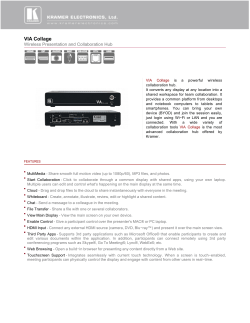
Network design
IS 477 BUSINESS DATA COMMUNICATIONS Network Design Introduction Issues in the design of a Local Area Network (LAN): Needs analysis – What do the users need from this network? Technological design – What devices are needed to properly support the demands that will be put on the network? Cost assessment – Can I afford it?! The Traditional Approach Following a structured systems analysis and design process: The network analyst met with users to determine the needs and applications The analyst estimated data traffic on each part of the network The analyst designed circuits needed to support this traffic and obtains cost estimates Finally, a year or two later, the network is implemented Problems The underlying technology (computers, networking devices, and circuits) is rapidly changing a couple of years is too slow The growth in network traffic is immense everyone wants to be “hooked up” now The balance of costs has changed dramatically over the last 10 years Token Ring overtaken by Cat5 Fast Ethernet Building Blocks Approach Begin by identifying applications and users, then define each as being either: Typical low volume or traffic from this node in the network High traffic heavily used application or user, suggesting high traffic node within the network Then design a network to support this 2x2 matrix 2x2 Classification Table APPLICATION Typical Typical 100 High Traffic 100/1000 USER High Traffic 100/1000 ??? Classifying Applications Review the list of applications that currently use the network Identify the location of each one Identify the hardware and software requirements (baselining) In many cases, the applications will be relatively well defined Classifying Users Application systems used to account for the majority of network traffic. Today, use of the Internet (i.e. e-mail and WWW) produce most network traffic Therefore, you must also assess the number and type of users that will generate and receive network traffic And So … Assess the relative amount of traffic generated in each segment, based on some rough assessment of the relative magnitude of network needs (i.e. typical vs. high volume) “Typical” users are allocated the “base level” client computers, as are servers supporting “typical” applications. “High volume” users and servers are assigned some “advanced” computers and possibly dedicated or higher capacity network segments. Looking For Hardware? CDW: www.cdw.com Useful catalog of basic and professional grade networking equipment White’s LAN Example What type of system will interconnect twenty workstations in one room and 15 workstations in another room to a central server, which offers: Internal e-mail A database that contains all customer information High quality printer access Nomenclature P1 Typical PC (1.5GHz) M Modem P2 High Traffic PC (2.8GHz) H Hub PR Printer FS File Server EF Email/Fax Server SW Switch R Router An easier way to draw (ALT I) T1 P1 R Wiring Closet Technical Services Cat5e SW FO Administrative Services SW P1 Cat5e x16 Cat5e PR P1 FO FS x4 x12 P1 x3 Maintenance Room PR An easier way to draw (ALT II) DSL MS Technical Services P1 x20 Administrative Services FO Cat5e SW Cat5e PR Cat5e SW Cat5e FO DS x4 SW Cat5e PR x2 Maintenance Room Cat5e P1 x15 Network Modeling To identify each connection between sites: d = distance of the connection (usually shown in either miles or kilometers) s = security level (high, medium, low, or none) du = duplexity (full duplex, half duplex, or simplex) dr = data rate desired (in bps) l = latency, or acceptable delay time across the network (usually in milliseconds, or ms) QoS = Quality of Service (CBR - constant bit rate, VBR variable bit rate, ABR - available bit rate, UBR - unreliable bit rate, or none) De = Delivery rate (throughput percentage) Summary In order to construct a LAN, you must: Carry out a needs analysis, in order to develop a technological design, and cost assessment You need to know the needs of the company before you can design the LAN, but not every company can afford the LAN they need! The designs should: Show the logical connection of users Show the support for traffic between nodes (connectivity maps) Allow a technically-competent technician to install the physical LAN layout
© Copyright 2025











